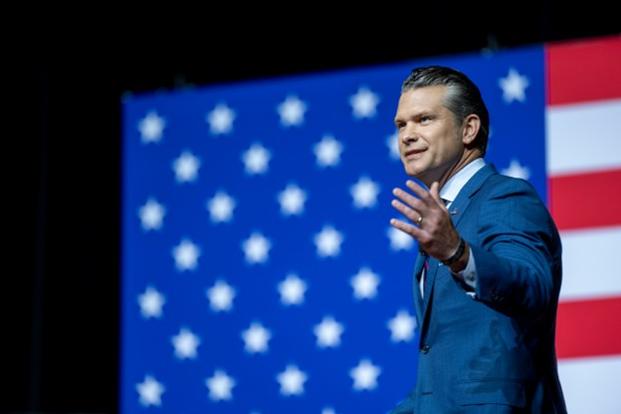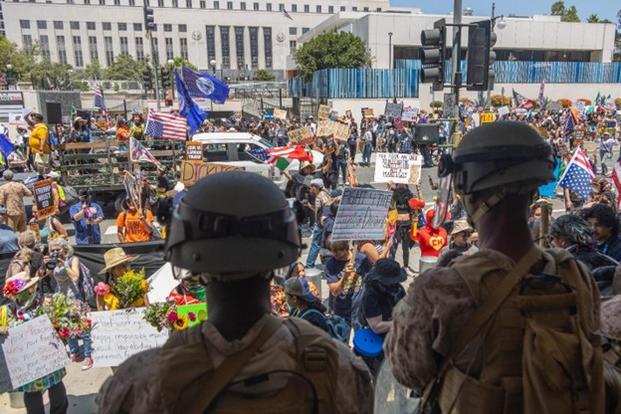On Sept. 30, 2025, at Marine Corps Base Quantico, President Donald Trump told hundreds of military officials that American cities should serve as “training grounds” for U.S. troops, a proposal that would test longstanding civil-military boundaries and would likely face immediate legal challenges.
“I told Pete, we should use some of these dangerous cities as training grounds for our military,” Trump said, referring to War Secretary Pete Hegseth. “We’re going into Chicago very soon.”
Trump’s remarks came during a hastily convened meeting at Marine Corps Base Quantico, where the White House flew in hundreds of generals and admirals. The meeting itself was unprecedented. Trump cast crime and immigration as internal threats that require a domestic military response.
Trump made clear which cities he had in mind. “Inner cities are a big part of war,” he said, before singling out Los Angeles, Portland, Seattle, and Washington. “I will never hesitate to protect our people from the horrible plague that is taking place from within.”
The president has repeatedly targeted Democratic-led cities in his rhetoric, and aides have hinted the concept could expand to Baltimore, Chicago, New York City, and Atlanta.
A New Military Culture
Hegseth reinforced Trump’s message by also pledging to roll back what he called “politically correct” policies inside the military. “The era of politically correct, overly sensitive don’t-hurt-anyone’s-feelings leadership ends right now at every level,” he told the audience. He vowed to reinstate strict fitness and grooming standards, including a ban on beards, and said combat arms roles would be held to “the highest male standards” — a move that could sharply restrict women’s participation.
Politico reported his reform package also targeted other diversity and inclusion programs. Critics argue this massive military overhaul risks politicizing the force at the very moment the administration is pressing for a larger domestic role.
Troops reshaped around a more rigid “warrior ethos” are designed for combat, not for policing American neighborhoods. That discrepancy could heighten tensions and complicate cooperation with civil authorities if units are ordered into U.S. cities.

Legal Limits
Trump’s suggestion to use U.S. neighborhoods as live training sites also runs into long-standing legal barriers. The Posse Comitatus Act, first passed in 1878, bars federal troops from enforcing domestic law without congressional approval. The Insurrection Act provides an exception, allowing presidents to deploy the military during rebellion or when state authorities cannot maintain order.
But using real cities as training zones would be a sharp departure from how those laws have historically been applied. Presidents have rarely invoked it, such as Dwight Eisenhower sending federal troops to enforce school desegregation in Little Rock in 1957 and George H.W. Bush deploying soldiers and Marines during the Los Angeles riots in 1992.
That legal boundary has already been tested. In August, Trump sent federal troops to Los Angeles during protests over immigration raids. A federal judge later ruled the move unlawful under the Posse Comitatus Act, and California Attorney General Rob Bonta called federalizing the National Guard “an abuse of the President’s authority under the law.” The Justice Department has appealed the ruling.
Governors remain split over Trump’s domestic troop deployments. Some Republican leaders have requested federal forces, while Democrats have largely resisted, saying the moves undermine their control of the National Guard and risk worsening unrest.
Risks for the Force and the Country
Trump’s proposal risks blurring the line between fighting wars abroad and policing Americans at home. The military has long touted itself as one of the country’s most trusted institutions, partly because it has stayed out of partisan politics. Using federal troops in a law enforcement role, experts say, could erode that trust and put troops into direct confrontations with American citizens.
As Sen. Jack Reed put it, “Law and order is a civil function under the Constitution … not the U.S. military.”
Pairing tougher standards with domestic deployments could hurt morale and drive out experienced troops, leaving a smaller and less experienced force. Putting that force into constitutionally contested roles risks incidents with American citizens that could end in injuries or deaths.
Such deployments can lead down a slippery slope: what begins as support for law enforcement can expand into detainments, escalating clashes, or even troops and civilians exchanging fire. In Los Angeles, federal troops were already documented as detaining civilians during immigration raids. Should casualties occur — military or civilian — the military will lose its long-established non-partisan trust with the American population and risk sparking civil conflict.

What Comes Next
Trump has not issued an executive order or directive to formalize the “training grounds” idea, and the Pentagon has released no guidance. However, the deployment of federal troops to LA and Trump’s repeated remarks about Chicago and other Democratic cities show he may push to make the idea a reality.
But governors and civil-liberties groups are already preparing legal challenges should the White House press forward. The issue could reach the Supreme Court, where justices may be asked to decide whether the President’s Commander in Chief authority extends to using American neighborhoods as military training sites.
In the meantime, the armed forces face a serious dilemma, caught between a Commander in Chief pressing for a larger domestic role and laws designed to keep the military off of America’s streets.












